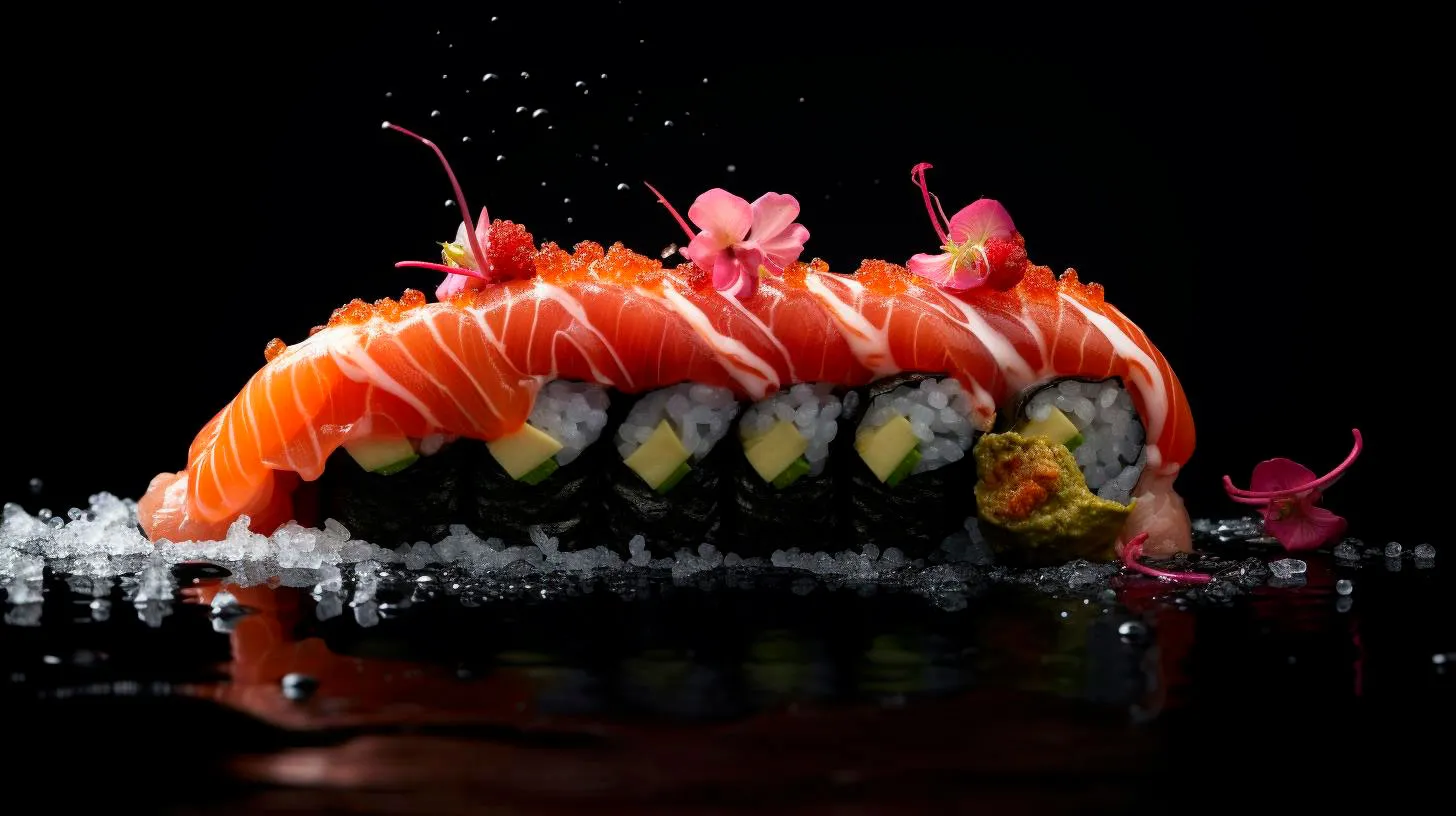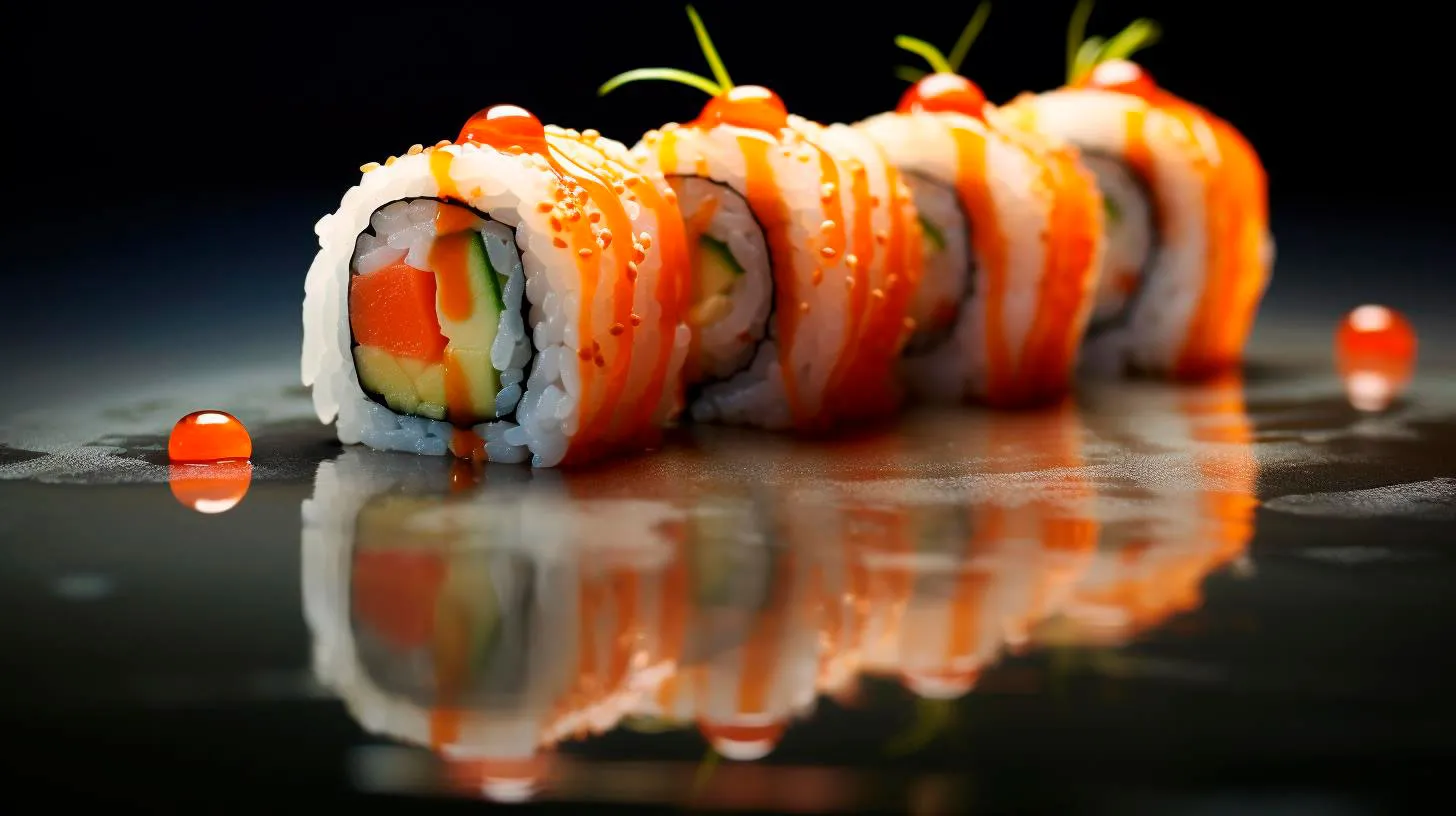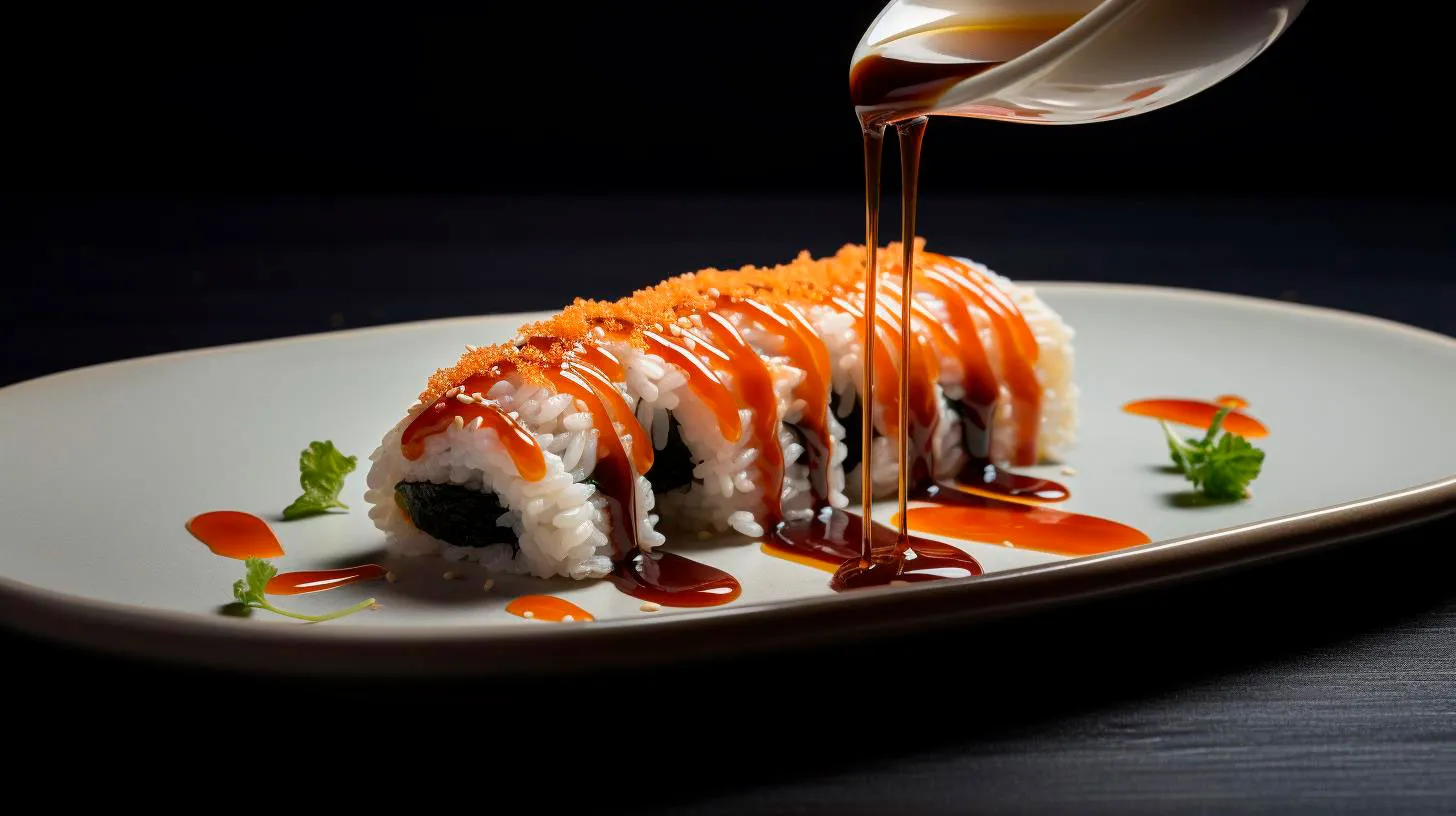Modern Sushi Trends: A Culinary Revolution in the Making
In this article, we will explore the modern sushi trends that are shaping the future of this beloved cuisine.
Fusion Sushi: Where Tradition Meets Innovation
Gone are the days when sushi was confined to traditional ingredients like raw fish and seaweed. Fusion sushi is the new rage, blending diverse culinary influences with the art of sushi-making. Chefs are experimenting with ingredients like avocado, cream cheese, and even fruits to create unique and tantalizing rolls. These innovative combinations not only add a refreshing twist to the traditional flavors but also cater to the evolving preferences of the global palate.
- Key Takeaway: Fusion sushi offers a delightful convergence of flavors, appealing to adventurous food enthusiasts.
- Advantage: It opens up sushi to a wider demographic, including those who may be hesitant to try raw fish.
Locally-Sourced and Sustainable Ingredients
In an era dominated by sustainable practices and eco-conscious consumers, sushi chefs are increasingly focusing on locally-sourced and sustainable ingredients. By utilizing local seafood and seasonal produce, they aim to support local communities and reduce their carbon footprint. This not only emphasizes freshness but also ensures the long-term viability of the seafood industry.
- Feature: Sushi made with locally-sourced ingredients allows for an authentic taste experience specific to the region.
- Advantage: It promotes environmental sustainability and encourages responsible sourcing practices.
Omakase: Trust the Chef’s Expertise
Omakase, meaning “chef’s choice,” is a trend that has gained popularity in recent years. It involves putting complete trust in the chef to curate a one-of-a-kind sushi experience. Rather than ordering specific items, diners leave the selection to the skill and creativity of the sushi master. This allows the chef to showcase their expertise and surprise patrons with an assortment of seasonal delicacies.
- Feature: Omakase offers a personalized and exclusive dining experience, tailored to individual preferences.
- Advantage: It allows the diner to explore new flavors and combinations with each visit, fostering a sense of culinary adventure.
Vegan and Plant-Based Sushi
In response to the growing demand for plant-based options, sushi chefs have started embracing vegan and vegetarian ingredients. From creative rolls featuring tofu and plant-based proteins to veggie-packed sashimi alternatives, vegan sushi is gaining immense popularity among health-conscious diners. These plant-based offerings showcase the versatility of sushi and cater to dietary restrictions without compromising on taste.
- Key Takeaway: Vegan sushi brings diversity to the sushi menu, accommodating different dietary preferences.
- Advantage: It taps into the expanding market segment of health-conscious individuals seeking plant-based options.
Sushi Delivery: Convenience at Your Doorstep
In the age of technology, sushi delivery has become a game-changer for the industry. With online ordering platforms and dedicated delivery services, sushi enthusiasts can now enjoy their favorite rolls at the comfort of their homes. This trend has gained popularity, particularly during the Covid-19 pandemic, as it provides a safe and hassle-free dining experience without compromising on quality.
- Feature: Sushi delivery services offer convenience, saving time and effort for those craving a sushi fix.
- Advantage: It expands the customer base by catering to individuals who prefer dining at home or are unable to visit sushi restaurants.
As the sushi industry continues to evolve, these modern trends highlight the ingenuity and adaptability of sushi chefs worldwide. Whether it’s through fusion flavors, sustainable practices, personalized dining experiences, vegan options, or convenient delivery services, sushi is undoubtedly undergoing a culinary revolution.
Key Takeaways:
1. Fusion sushi combines diverse ingredients to create an exciting and unconventional culinary experience.
2. Locally-sourced and sustainable ingredients promote environmental sustainability and support local communities.
3. Omakase offers a unique dining experience by trusting the chef to curate a personalized selection of sushi.
4. Vegan and plant-based sushi caters to the growing demand for plant-centric dining options.
5. Sushi delivery services provide convenience and safety, making sushi accessible to a wider audience.
Keep up with the latest sushi trends and embark on a gastronomic adventure that will transport you to the heart of Japan’s culinary scene. Whether you prefer traditional flavors or crave innovative fusion creations, modern sushi trends have something to offer for every palate. Experience the revolution and savor the artistry of sushi like never before!
Cultural Celebration through Culinary Arts
Join us on this flavorful journey!
The Power of Culinary Arts
Culinary arts has always been an essential part of any culture. It not only brings people together but also provides an opportunity to showcase the diversity and uniqueness of each community. Here’s why culinary arts is a powerful tool for celebrating culture:
- Preserving Tradition: Traditional recipes passed down through generations help to preserve cultural heritage by showcasing the authentic flavors and techniques of a community.
- Sharing Stories: Each dish has a story to tell. Through culinary arts, communities can share their history, values, and beliefs with others, creating a deeper understanding and appreciation for different cultures.
- Bridging Cultures: Food has the power to break down barriers and bring people from different cultures together in a shared experience. Culinary festivals and events provide a platform for cultural exchange and promote harmony.
- Economic Impact: Culinary tourism adds value to local economies by attracting visitors who are eager to explore the unique flavors and food experiences of a region.
Celebrating Diversity with Food
Food is the ultimate expression of cultural diversity. It reflects the local produce, climate, and geographical influences of a region. Here are a few examples of how different cultures celebrate their diversity through culinary arts:
Mexican Cuisine
Mexican cuisine is a vibrant fusion of Indigenous, Spanish, and Mexican-American flavors. It celebrates the rich cultural history of Mexico through its traditional dishes such as tacos, tamales, and mole. Key takeaways from Mexican cuisine include:
- The use of fresh ingredients like corn, chili peppers, and avocados.
- A balance of flavors, combining spicy, sweet, and savory elements.
- The art of making tortillas from scratch, showcasing the skill and craftsmanship of traditional cooking methods.
Indian Cuisine
Indian cuisine is as diverse as its people, with each region having its distinct flavors and cooking styles. It celebrates its cultural heritage through a myriad of spices, herbs, and cooking techniques. Key takeaways from Indian cuisine include:
- The use of aromatic spices like cumin, turmeric, and cardamom, adding depth and complexity to dishes.
- A wide variety of vegetarian and vegan options, showcasing the importance of plant-based ingredients in Indian culture.
- The art of tandoori cooking, using a traditional clay oven to create delicious dishes like naan and tandoori chicken.
Cross-Cultural Culinary Festivals
In today’s interconnected world, cross-cultural culinary festivals are becoming increasingly popular. These events provide a platform for communities to come together and celebrate their diverse culinary traditions. Here are a few notable culinary festivals around the globe:
- Taste of Chicago: Held annually in Chicago, Illinois, this festival showcases the city’s diverse culinary scene, featuring both local and international cuisine.
- Oktoberfest: Originating in Munich, Germany, this world-famous festival celebrates German culture through beer, traditional music, and authentic Bavarian cuisine.
- Mid-Autumn Festival: Celebrated in many East Asian countries, this festival brings families together to enjoy mooncakes and appreciate the beauty of the full moon.
The Future of Culinary Arts
As the world becomes more interconnected, culinary arts will continue to play a vital role in cultural celebrations. Here are some trends shaping the future of culinary arts:
- Technological Advancements: Innovations like 3D food printing and virtual reality dining experiences will push the boundaries of culinary arts, creating new and unique ways to celebrate culture through food.
- Sustainability and Locally Sourced Ingredients: There is a growing awareness of the environmental impact of food production. The future of culinary arts will prioritize sustainable practices and promote the use of locally sourced ingredients.
- Fusion Cuisine: With increased globalization, fusion cuisine will continue to evolve, blending different culinary traditions to create exciting new flavors and dishes.
In conclusion, culinary arts is much more than just cooking. It is a powerful tool for celebrating culture, sharing stories, and bridging gaps between communities. So, let us savor the flavors of different cultures and appreciate the beauty of cultural diversity through the culinary arts!
Exploring the Irresistible Delicacies of Japanese Festivals
Let’s embark on a flavorful journey to discover the irresistible delicacies that adorn Japanese festivals, and learn why these dishes hold a special place in the hearts of both locals and tourists alike.
Takoyaki: Pillowy Octopus Treats
If you’re a fan of seafood, you cannot resist the allure of takoyaki – those mouthwatering octopus-filled dumplings!
- Crunchy on the outside, yet soft and pillowy on the inside, takoyaki is a true flavor explosion.
- These round-shaped delicacies are made from a batter of flour, eggs, and dashi (a type of Japanese stock).
- A piece of tender octopus is placed within the batter, and the mixture is carefully cooked in a special cast-iron pan with multiple rounded molds.
- The final touch includes drizzling takoyaki sauce, Japanese mayonnaise, and sprinkling bonito flakes and dried seaweed on top.
- Key Takeaway: Takoyaki is a savory treat that encapsulates the umami flavors of tender octopus combined with a well-balanced medley of sauces and accompaniments.
Yakitori: Skewered Grilled Goodness
No matsuri experience is complete without indulging in the heavenly taste of yakitori – tantalizing grilled skewers that make your taste buds dance with joy!
- Yakitori traditionally refers to skewered and grilled chicken, but it has expanded to include a variety of mouthwatering ingredients like beef, pork, seafood, and even vegetables.
- The secret behind the flavorful yakitori lies in the mouthwatering tare sauce made from soy sauce, mirin, sake, and sugar, which is brushed onto the skewers during grilling.
- These bite-sized delicacies are usually enjoyed with a side of tare sauce, negima (grilled chicken with leeks), or shio (lightly salted).
- Key Takeaway: Yakitori offers a scrumptious and convenient way to savor various proteins and vegetables in a lively festival atmosphere. The dance of flavors created by grilling and the umami-rich tare sauce is truly unforgettable.
Okonomiyaki: Japan’s Flavor-Packed Pancake
Okonomiyaki, often referred to as “Japanese pancakes” or “Japanese pizza,” is a beloved festival staple that satisfies every craving for comfort food.
- Originating from the Kansai region, okonomiyaki is made by mixing flour, shredded cabbage, eggs, and dashi, and then adding an assortment of ingredients such as pork, seafood, or vegetables.
- Once cooked on a hot grill, this savory pancake is beautifully adorned with a special okonomiyaki sauce, tangy Japanese mayo, bonito flakes, and dried seaweed.
- Key Takeaway: Okonomiyaki combines the crunch of cabbage, the savoriness of protein, and the bold flavors of sauces and seasonings. It’s an explosion of taste and textures that delights the senses at any Japanese festival.
Mitarashi Dango: Sweet Tooth’s Paradise
Japanese festivals also cater to those with a sweet tooth, and mitarashi dango is an absolute must-try delicacy for dessert lovers.
- Mitarashi dango consists of chewy rice dumplings skewered onto a stick, which are then drizzled with a rich, sweet soy glaze.
- The glaze, made from soy sauce, sugar, and sometimes mirin, caramelizes and creates a delightful contrast with the soft, slightly sticky texture of the dango.
- These bite-sized treats are often served in groups of three or four, making them perfect for sharing and satisfying your sweet cravings.
- Key Takeaway: Mitarashi dango’s simple yet irresistible combination of sticky rice dumplings and sweet soy glaze makes it a heavenly treat for dessert enthusiasts.
The Allure of Japanese Festival Delicacies
Japanese festival delicacies are more than just food; they are an integral part of the vibrant culture and celebration that define these events. From savory takoyaki to sweet mitarashi dango, these culinary delights offer an explosion of flavors and textures that leave a lasting impression.
Whether you’re exploring the lively streets of Osaka during the Tenjin Festival or experiencing the dazzling colors of cherry blossoms during Hanami, indulging in these delicacies will undoubtedly enhance your festival experience.
So, the next time you find yourself at a Japanese festival, be sure to immerse yourself in the mouthwatering world of takoyaki, yakitori, okonomiyaki, and mitarashi dango. Your taste buds will thank you!
Fusion of Tradition and Innovation: Embracing Technology to Preserve Cultural Heritage
By harnessing the power of innovation, we can not only preserve our rich cultural heritage but also make it accessible to a global audience. This article delves into the exciting possibilities that arise when tradition and innovation collide.
Preserving the Past with Technology
Preserving cultural heritage is crucial for future generations to understand their roots and appreciate the legacy left by their ancestors. Technology plays a pivotal role in safeguarding these traditions, making them accessible and engaging for a wider audience. Here are a few remarkable ways in which heritage preservation leverages technological advancements:
- Digitization of artifacts: Museums and cultural institutions around the world are investing in digitizing their collections. By creating high-resolution images, 3D models, and virtual tours, people can explore these exhibits from the comfort of their homes.
- Virtual reality (VR) experiences: With VR technology, individuals can immerse themselves in realistic recreations of historical sites or events. This not only brings history to life but allows for interactivity and exploration that was previously impossible.
- Augmented reality (AR) applications: AR enhances our perception of reality by overlaying digital information onto the physical world. Cultural heritage apps incorporating AR allow visitors to gain deeper insights into artifacts or locations by simply pointing their smartphones or tablets at them.
- Online archives: Digital archives provide easily accessible databases of historical documents, photographs, and recordings. This allows researchers, scholars, and enthusiasts worldwide to access invaluable resources remotely.
Advantages of Embracing the Fusion
The fusion of tradition and innovation offers numerous advantages that propel cultural heritage into the digital age. Here are some key benefits:
- Global accessibility: By embracing technology, cultural heritage becomes accessible to a global audience, regardless of geographical barriers. This widens the reach and encourages cross-cultural exchange.
- Preservation against physical deterioration: Digital preservation ensures that rare artifacts or monuments are protected against damage, theft, or natural disasters. Even if the physical objects are lost, their digital counterparts remain intact.
- Enhanced educational experiences: Technology brings history to life, making it more engaging for students and educators. Interactive elements, such as VR or AR, enable immersive learning experiences, fostering a deeper understanding and appreciation of cultural heritage.
- Economic opportunities: The fusion of tradition and innovation opens up new avenues for economic growth. Cultural tourism, driven by virtual experiences, can boost local economies and create jobs in sectors like virtual reality development, content creation, and digital preservation.
Key Takeaways
The synergy between tradition and innovation is evident in the preservation of cultural heritage. Embracing technology allows for the safeguarding of our rich past while making it accessible and engaging for a global audience. Here are the key takeaways from this exploration:
- Technology plays a vital role in preserving cultural heritage by digitizing artifacts, creating immersive VR experiences, and developing AR applications.
- The fusion of tradition and innovation provides global accessibility, safeguards against degradation, enhances educational experiences, and unlocks economic opportunities.
- Preserving cultural heritage benefits future generations, fostering cross-cultural exchange, and nurturing a deeper understanding of our roots.
As we move forward, let us embrace the fusion of tradition and innovation, leveraging technology as a powerful tool to honor the past, inspire the present, and pave the way for a culturally rich future.


